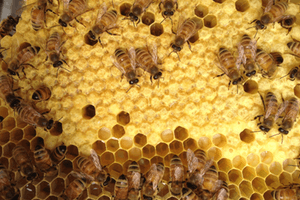- All-In-One Beekeeping for the Bees
- +1-608-728-8233
- info@beepods.com
What You Need to Know About Forage for Bees, and How You Can Help Them!


Today we’re covering everything you need to know about forage: how bees use it, where they get it, and what sources they enjoy the most. We’re also giving you tips for creating a sustainable garden, full of delicious plants for bees and other pollinators. Let’s get started!
What Bees Forage For and Why
Just as different foods give us a mix of nutrients for our bodies, bees need a variety of forage to support their hive and maintain a healthy colony. Here’s a look at how bees use different types of forage.
Nectar
This sweet, watery substance is secreted by flowers, leaves, and stems. Bees sip it up in its raw form and transport it to the hive, where it’s turned into honey. Nectar is also an excellent source of carbohydrates for bees, which gives them the energy for their daily activities.

This lady is was so busy foraging, she got pollen all over herself!
Pollen
Pollen, which develops from microspores produced by male plants, is a powdery protein source. Bees collect it on their hind legs when they visit plants, and bring it back to the hive. Workers store the pollen and use it for cooking up bee bread, and then brood food, which is created by nurse bees eating the bee bread to produce royal jelly.
Honorable Mention: Plant Resins
They’re not as well-known as nectar and pollen, but plant resins are important to bees!
Like pollen, bees collect resins on their hind legs. In the hive, they make propolis (bee glue) by mixing the resins with beeswax and saliva. Propolis is used for various bee purposes, ranging from strengthening the hive to fighting off infection.
For information on the nutritional value of forage for bees, check out Caitlin’s recent blogs on honey, pollen, and feeding bees.
Going the Distance
Bees will fly about two miles to get their pollen baskets on forage, and researchers have observed them flying two to three times that distance in some cases. However, flying too far can exhaust bees and shorten their lifespans, so it’s ideal for them to have sources nearby!
Once they’ve visited an excellent forage spot, they spread the word back at the hive. Bees share directions to the spot with the waggle or round dances. The dances give worker bees the inside scoop on the shortest possible route, or beeline, to the good stuff.
Bees have incredible navigation skills and also use their unique vision capabilities to spot attractive flowers and other plants on the fly. Check out my blog on how bees see to learn more about how bees’ vision helps them find forage.
Favorite Forage Sources
Bees and other pollinators are attracted to a wide variety of blooming plants, and some hold more appeal than others. For example, when it comes to flowering plants, those with single flower tops typically produce more nectar and are easier for bees to navigate than those with double-headed flowers. Bees also zone in on plants with white, yellow, violet, and blue flowers. They are also attracted to “bee’s purple,” which they can see given their UV vision abilities.
Beyond flowers, here are just a few of the plants and vegetation bees are known to enjoy:
- Garden plants: cucumbers, strawberries, and peppers
- Trees: maple, willow, and fruit trees
- Herbs: lavender, mint, and thyme
- Shrubs: honeysuckle, blueberry, and privet
Sustainable Gardening for Pollinators

Pollinators love a garden that hosts a variety of forage.
Growing a sustainable garden is a great way to provide pollinators with diverse forage. And, you’ll enjoy the fruits of your labor (pun intended)! A sustainable, pollinator-friendly garden doesn’t require much more than a standard one. With some planning, you can make a pollinator haven.
Starting with a sunny spot is ideal. Fill it with patches of plants and year-round blooms to ensure forage is available every season. And, even if it goes against all of your gardening instincts, let weeds grow – the pollinators will thank you for it! Also, skip the pesticides, and create a safe, forage-ful environment for bees and other winged friends.
Interested in creating a sustainable garden pollinators will flock to? Check out Sustainable Gardening 101 in Beepods Lab. The course covers everything you need to know about creating a pollinator-friendly garden. From sustainable mindsets and pollinator garden goals, to grow zones and eco-friendly design, you’ll walk away with all of the information and tools you need to start a sustainable garden pollinators will love.
Conclusion
Forage is essential to balance bee diets and help their hives prosper, so it’s essential they have access to a variety of sources. Now that you know why bees forage, and what sources are ideal for them, we hope you’ll consider creating your own pollinator oasis with a sustainable garden!
Want to learn more about taking care of bees and supporting pollinators?
Beepods Lab is FULL of informative resources, videos, tips, and tools to help you get started.
Kanoe Riedel
Latest posts by Kanoe Riedel (see all)
- This Spring, Don’t Forget Why Bees Are So Important to Our Environment - March 26, 2021
- 11 Awesome Uses for Your Stored Honeycomb - March 2, 2021
- How the Right Beekeeping Equipment Makes Inspections Better for Beekeepers and Bees - February 12, 2021



